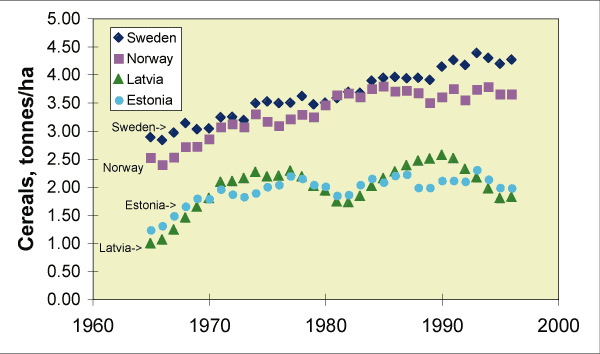


 |  |  | 3.5 The management of diffuse agricultural pollution sources |
The EC Directive 2000/60/EC (The Water Framework Directive) sets the scene for the future management of water resources at watershed level in Europe. It is basically action oriented, in terms of maintaining or, if necessary, improving the ecological status of the water resources. When dealing with diffuse agricultural sources, it is also necessary to consider the sustainability aspects related to agricultural production. One should bear in mind that the present agriculture to a large extent mirrors the market conditions for agricultural produces, and that socio-economic implications often are integrated effects of changes in the agricultural structures.
The management of the diffuse agricultural pollution sources must be based on the best possible knowledge being:
In many cases the question of interest is not only reducing the losses, but also how to avoid increased losses. Especially the last aspect might well be the case in some areas of the Baltic States, provided increased agricultural activities occur due to increased activities in the Baltic economies.
One typical characteristic of the Baltic agriculture during the Soviet time was the rather low efficiency in crop production. The fertiliser use was at a typical Nordic level with N-applications varying from 100-120 kg N ha-1 while crop yields were only about half (see Figure 4).

The plant nutrient management is of particular importance for the nutrient loss potentials, especially on animal farms. Balanced fertilisation, according to crop nutrient requirement, is an important measure to control the nutrient losses. But all measures that increase the efficiency in crop uptake of applied nutrients may also contribute to reduced losses (e.g. irrigation, corrections for micro-nutrient deficiencies, weed control). In many cases, however, it is the handling of animal manure that represent the most critical issue in terms of nutrient management. The animal manure is a valuable nutrient sources with high contents of N, P and K. It is therefore important to enhance the recycling of these nutrients and to optimise its utilisation in agricultural production through proper collection and storage routines and through proper application methods. Inappropriate storage and application methods (e.g. winter application, too high amounts on a limited land area) may cause high losses of highly bio-available nitrogen and phosphorus, whereas the high contents of digestible organic matter may cause oxygen deficiencies in local recipients. A nutrient accounting system on field and farm level may be an important instrument in order to avoid excessive use of plant nutrients and resulting high nutrient losses. This system would need to take account of all available nutrients, in particular the animal manure, and adjust the application of commercial fertilisers in order to balance the total application to the crop nutrient requirements.
Another possible strategy for the reduction of the environmental effects of agriculture may be to modify the hydrology in transforming nutrients. Controlled drainage [173] has proven to be an efficient measure in reducing nitrogen losses under certain conditions in the US. Low-land areas of the Baltic States may be well suited for this measure, in which ground water level during off-season periods is raised by blocking the subsurface drainage systems and thereby enhancing denitrification process. Ponds, constructed wetlands and buffer strips may also be useful measures that may significantly reduce the inputs of both N and P to surface waters.
In general, the management of diffuse nutrient losses has to take into account the complexity in the cause-effect relationships between the loss processes and the ameliorating factors. Measures must be site-specific, i.e. adjusted to the local conditions regarding soils, agricultural practices and the geo-hydrological setting. A clear understanding of the field and catchment hydrology especially concerning the pathways of nutrients from the soil profile to the receiving waters is needed. Bearing in mind the reduction targets as defined by e.g. HELCOM and OSPAR (50% reduction of nutrient inputs to the sea), the implications can be different under different hydrological situations. When having a system, mainly characterised by fast flow processes, a reduction in root zone losses can result in an immediate reduction of the nutrient input to the surface water. On the other hand, with a system mainly characterised by slow flow processes, even significant reductions in root zone losses may pass unnoticed by the time the water reaches the outlet stream of the catchment.
Considering the time scale involved in the transport processes, this also suggests that a long-term perspective has to be applied in the management of the diffuse agricultural pollution sources.
 |  |  | 3.5 The management of diffuse agricultural pollution sources |